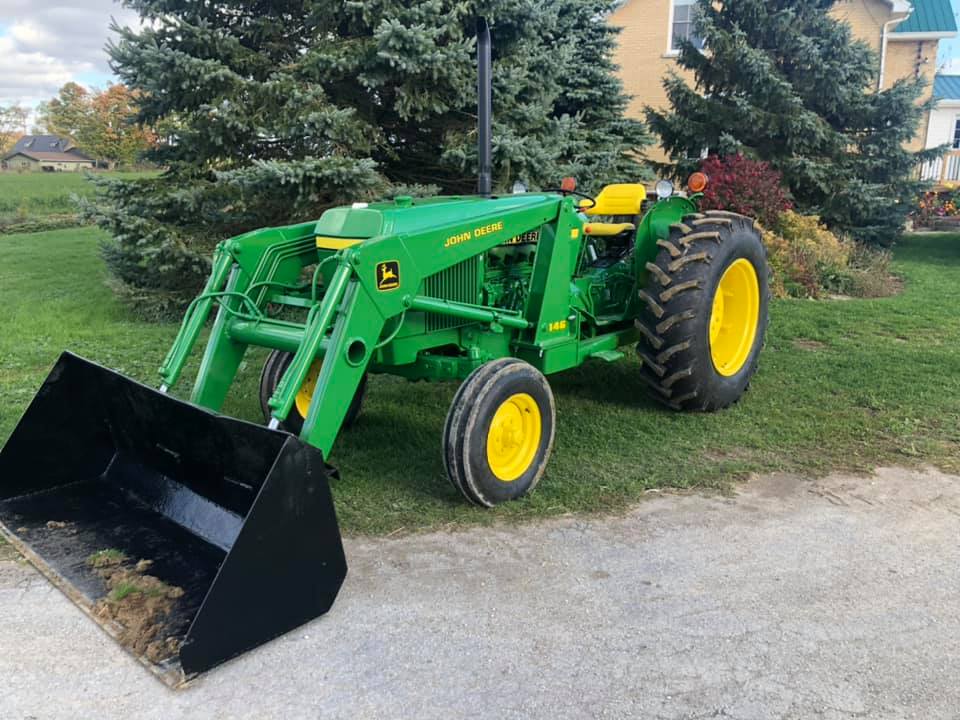The John Deere 1840 is a classic tractor model known for its reliability and versatility in various agricultural applications. It has been a trusted workhorse on farms for many years, appreciated for its robust construction and efficient performance. Farmers have relied on the 1840 to handle a wide range of tasks, from plowing fields to transporting goods, making it a staple in the world of farming equipment. Its enduring popularity is a testament to its enduring quality and the essential role it has played in supporting agricultural operations.
| JD 1840 Engine Technical Data | |
|---|---|
| Engine Model | John Deere |
| Engine Type | 4 Cycle, 4-cylinder diesel |
| Number of Cylinders | 4 |
| Displacement | 219.4 cu in (3.6 L) |
| Engine Bore | 4.02 inches (102.0 mm) |
| Engine Stroke | 4.33 inches (110.0 mm) |
| Aspiration | Natural |
| Compression | 16.2:1 |
| Rated Engine Power | 68.0 hp (50.7 kW) |
| Rated Engine Speed | 2500 rpm |
| Low Idle Speed | 950 rpm |
| High Idle Speed | 2700 rpm |
| Firing Order | 1-3-4-2 |
| Air Cleaner | Dry type |
| Valve Clearance (Intake) | 0.014 inches (0.356 mm) |
| Valve Clearance (Exhaust) | 0.018 inches (0.457 mm) |
| Fuel Tank Capacity | 19.5 gal (74.0 L) |
| Oil Capacity | 6.0 qts (5.7 L) |
| Coolant Capacity | 12.0 qts (11.4 L) |
| Electrical System Rating | 12 Volts |
| Charging System | Alternator |
| John Deere 1840 Power Take-Off | |
|---|---|
| PTO Operational Type (Std) | Live |
| PTO Operational Type (Opt) | Independent |
| PTO Horsepower | 60.0 hp (45.0 kW) |
| PTO Speed | 540 rpm |
| PTO / Engine Speed | 540/2100 rpm |
| JD 1840 Transmission | |
|---|---|
| Transmission Type (Std) | 8F/4R, Collar shift |
| Number of Forward Gears | 8 |
| Number of Reverse Gears | 4 |
| Clutch | Dry Disc |
| Maximum Speed (Forward) | 17.3 mph (27.8 kph) |
| Maximum Speed (Reverse) | 6.9 mph (11.1 kph) |
| Oil Capacity | 58.0 qts (55.0 L) |
| Transmission Type (Opt) 16F/8R, 2-Speed powershift | |
|---|---|
| Number of Forward Gears | 16 |
| Number of Reverse Gears | 8 |
| Clutch | Dry Disc |
| Maximum Speed (Forward) | 17.3 mph (27.8 kph) |
| Maximum Speed (Reverse) | 6.9 mph (11.1 kph) |
| Service Brake | Wet disc |
| John Deere 1840 Wheels and Tires | |
|---|---|
| Drive Wheels | 2WD/4WD |
| Steering Configuration | Front Steer |
| Steering System | Hydrostatic power |
| Front Tire Size | 6.00-16 |
| Rear Tire Size | 16.9-28 |
| Front Tread | 49-88 inches (1240-2230 mm) |
| Rear Tread | 50-96 inches (1270-2430 mm) |
| JD 1840 Hydraulics and Hitch | |
|---|---|
| Hydraulic System Type | Closed center |
| Implement Pump Flow | 6.1 gpm (22.7 Lpm) |
| Hydraulic Pressure | 155 Bar (2550 psi) |
| Hydraulic Capacity | 10.0 gal (37.8 L) |
| Number of Standard Remote Valves | 1 |
| 3-Point Hitch Category | 2 |
| Draft Sensing or Lift Control | Position control and lower-link draft sensing |
| Standard Lift Capacity 24″ behind pin | 2400 lb (1090 kg) |
| John Deere 1840 Dimensions and Weight | |
|---|---|
| Wheelbase (Std) | 85.8 inches (2170 mm) |
| Wheelbase (Opt) | 79.5 inches (2010 mm) |
| Length | 139.5 inches (3540 mm) |
| Height (Hood) | 61.3 inches (1550 mm) |
| Height (Exhaust) | 101.7 inches (2580 mm) |
| Width | 69.5 inches (1760 mm) |
| Ground Clearance | 25.4 inches (640 mm) |
| Weight | 4750 lb (2155 kg) |
Advantages of the John Deere 1840 Tractor
Reliability: John Deere is known for manufacturing reliable and durable tractors, and the 1840 is no exception. It can withstand tough working conditions and is built to last.
Versatility: This tractor offers versatility with different transmission options (standard and optional powershift) and power take-off configurations, making it suitable for various farming tasks.
Fuel Efficiency: The tractor’s 4-cylinder diesel engine, with natural aspiration and efficient design, provides decent power while conserving fuel, which can lead to cost savings over time.
Hydraulic System: The closed-center hydraulic system and standard remote valves make it compatible with a range of implements and attachments, enhancing its productivity.
Compact Design: The 1840’s compact design, combined with good maneuverability, makes it suitable for smaller farms or operations with limited space.
Disadvantages of the John Deere 1840 Tractor:
Limited Features: Compared to modern tractors, the 1840 lacks some advanced features and technology, which could affect overall efficiency and ease of use.
Comfort: The tractor’s cabin and operator comfort features may not meet modern standards, potentially leading to operator fatigue during long working hours.
Maintenance: As an older model, finding replacement parts and qualified mechanics for maintenance and repairs might be more challenging and expensive.
Lack of Safety Features: The 1840 may lack modern safety features such as rollover protection systems (ROPS) and other safety enhancements, posing risks to the operator.
Lower Speed: Its maximum speed, while suitable for farming tasks, may be slower compared to newer tractors, which could affect efficiency in transport and field operations.
